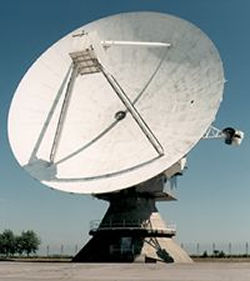
The 3 GHz Chilbolton Advanced Meteorological Radar (CAMRa) is the largest fully steerable meteorological radar in the world. The 25 metre dish is located at the Chilbolton Observatory in England (UK). The large antenna of the 3 GHz weather radar gives it both high sensitivity and a very narrow beam. It has dual-polarisation capability, which means that it can transmit and receive both horizontally and vertically polarised pulses. This makes it possible to determine the shape and orientation of cloud and precipitation particles in the atmosphere. It also has full 'Doppler' capability, which means it can map the radial component of a wind field.
The scan-type is usually 'ppi' (plan-position indicator, i.e. a horizontal scan) or 'rhi' (range-height indicator, i.e. a vertical scan). Chilbolton Observatory is operated by the Radio Communications Research Unit of CCLRC Rutherford Appleton Laboratory.
The characteristics of the radar are:
|
Frequency |
3.075 GHz |
|
Antenna diameter |
25 metres |
|
Peak power |
560 kW |
|
Pulse width |
0.5 micro-sec |
|
Pulse repetition frequency |
610 Hz |
|
System noise figure |
1.3 dB |
|
Beamwidth |
0.28 degrees |
|
Range resolution |
300 m or 75 m |
|
Cross-polar isolation |
-34 dB |
|
Standard maximum slew rate |
1 degree/sec |
|
Unambiguous velocity |
15 m/s |
The data are in netCDF (binary) format and comply with the CF conventions ( NetCDF Climate and Forecast Metadata Convention (Eaton et al., 2001)).
If data are used in any publication or report then acknowledgement must be given to the Radiocommunications Research Unit at the Rutherford Appleton Laboratory for providing the data.
If you have problems obtaining the data, please contact the British Atmospheric Data Centre.